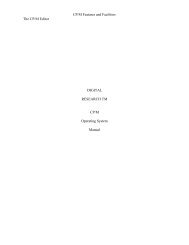DIGITAL RESEARCH(r) CP/M Plus TM (CP/M Version 3) Operating ...
DIGITAL RESEARCH(r) CP/M Plus TM (CP/M Version 3) Operating ...
DIGITAL RESEARCH(r) CP/M Plus TM (CP/M Version 3) Operating ...
Create successful ePaper yourself
Turn your PDF publications into a flip-book with our unique Google optimized e-Paper software.
The PIP Command <strong>CP</strong>/M 3 User's Guide<br />
A>PIP newfile.dat=oldfile.dat<br />
Using this long form of PIP, you can copy a file from one drive and<br />
user number (usually user 0 because <strong>CP</strong>/M 3 automatically starts out<br />
in user 0-the default user number) to the same drive and user number.<br />
This gives you two copies of the same file on one drive and user number,<br />
each with a different name.<br />
A >PIP B: PROGRAM. BAK=A:PROGRAM.DAT [GI ]<br />
The preceding command copies the file PROGRAM.DAT from user 1<br />
on drive A to the current selected user number on drive B and renames<br />
the filetype on drive B to BAK.<br />
B > PIP program2.dat=A:programl. dat [E V G3]<br />
In this command, PIP copies the file named programl.dat on drive A<br />
and echoes [E] the transfer to the console, verifies [V] that the two<br />
copies are exactly the same, and gets [G3] the file programl.dat from<br />
user 3 on drive A. Because there is no drive specified for the destination,,<br />
PIP automatically copies the file to the default user number and<br />
drive, in this case user 0 and drive B.<br />
Multiple File Copy<br />
Syntax: PIP d:{[Gn]} ={d:}wildcard-filespec{[options]}<br />
Explanation: When you use a wildcard in the source specification, PIP copies matching<br />
files one-by-one to the destination drive, retaining the original name<br />
of each file. PIP displays the message COPYING followed by each<br />
filename as the copy operation proceeds. PIP issues an error message<br />
and aborts the copy operation if the destination drive and user number<br />
are the same as those specified in the source.<br />
Examples: A > PIP B:=A:*.COM<br />
This command causes PIP to copy all the files on drive A with the<br />
filetype COM to drive B.<br />
5-66




